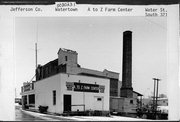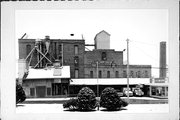| Additional Information: | Destroyed by fire May of 2001. This is the old Emerald Mill, later known as the Empire Mill, and the Globe Milling Company.
The original Emerald Mill was built around 1848 at this location on the middle dam. The mill burned in 1871, It was rebuilt as a brick mill and this original portion is the south part of the building. In 1874 Christian May purchased this mill and later consolidated it with F. Miller under the Globe Milling Company name. At this time the mill became known as the Empire Mill and Globe also included a large brick mill on the other side of the river. Around 1890, the old woolen mill, which had stood right next to the Empire Mill burned, and at that time the north portion of the existing building was built. In 1894 the other mill in the Globe Milling Company operation burned and was not rebuilt. At that time the Empire Mill became solely known as the Globe Mill. In 1898 the May family sold out their interest in the mill and it became owned by locally prominent businessmen Henry Mulberger and W.D. Sproesser. In 1917, an outside firm bought the mill. By the twentieth century, the mill began concentrating on rye flour exclusively and became the largest concern to solely mill rye flour in the early twentieth century. The mill still operates today as the A to Z Farm Center.
This mill is significant for local history under National Register criterion A, because it is the only extant flour mill remaining in the community. It was also the most significant mill in the twentieth century, with its emphasis on rye flour milling. It is also the only historic industry standing on the Rock River today.
Flour milling was a significant pioneer industry in Watertown and Wisconsin. The heavy production of wheat during the Civil War era resulted in a large number of mills built all over WIsconsin. Due to fire, neglect, and other demolition, most of these mills no longer exists today. In Watertown there were a least six flour mills. Of these, about four survived into the twentieth century. This mill was one of the most successful survivors, and as all the others succumbed to fire or demolition, it was remained the only extent flour mill in the city.
The mill also has significance because it was part of the large flour milling effort that the Globe Milling Company attempted to establish in the late nineteenth century. As the wheat frontier left Wisconsin, small mills were increasingly closed down. Only large operations could compete for the wheat that was being grown farther from the mills. The Globe Milling Company attempted to be a large mnilling concern, and for a time, they were successful. After the turn of the century, the company switched to total rye flour milling and achieved success with this type of industry during the early years of the twentieth century.
Lastly, this building is significant because of all the pioneer industries located on the three dams of the Rock River at Watertown, this is the only one to have survived into the modern era. For all these reasons, the Globe Mill meets the criteria for significance for local history.
An industrial complex constructed over a period of time beginning in 1871 when fire demolished the original wooden building, the Globe Mill is built of cream brick in a utilitarian manner. The oldest section located on the south end is a two-story building topped by a metal covered gable roofed elevator thatis further characterized by a raised brick cornice, round arched second story window and a one-story south extension. A brick smoke stack and power house is also located on the south end of the complex. The three-story section on the north end built in 1890 features a brick cornice, segmental arched windows with brick voussoirs with multipaned arched windows. Metal covered additions and covered entrances have been added on the rear, south and east sides of the building.
One of two extant mills in the city, the Globe Mill is significant under criterion C as an example of utilitarian industrial architecture and as the only historic mill remaining in the city. Although some alteration has occurred, the mill has been preserved with much of its exterior architectural character intact, although obscured by the more recent additions. The other mill is the much later mill at 815 North Church St. (26/18). |
|---|


